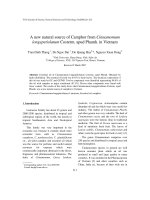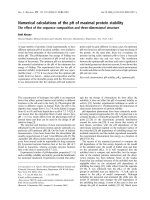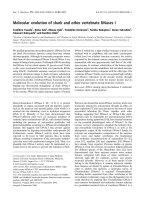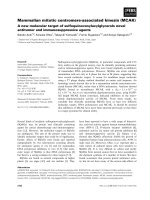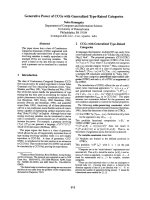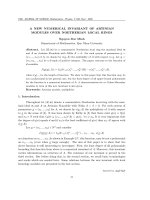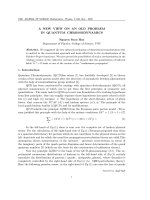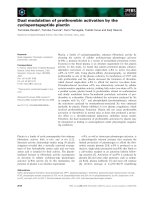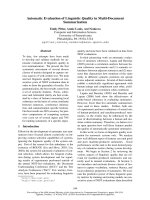Báo cáo "A NEW NUMERICAL INVARIANT OF ARTINIAN MODULES OVER NOETHERIAN LOCAL RINGS " pptx
Bạn đang xem bản rút gọn của tài liệu. Xem và tải ngay bản đầy đủ của tài liệu tại đây (204.69 KB, 11 trang )
VNU. JOURNAL OF SCIENCE, Mathematics - Physics. T.XXI, N
0
2 - 2005
A NEW NUMERICAL INVARIANT OF ARTINIAN
MODULES OVER NOETHERIAN LOCAL RINGS
Nguyen Duc Minh
Department of Mathematics, Quy Nhon University
Abstract.
Let (R, m) be a commutative Noetherian local ring the maximal ideal m
and A an Artinian R-module with Ndim A = d. For each system of parameters x =
(x
1
, ,x
d
) of A, we denote by e(x,A) the multipility of A with respect to x. Let n =
(n
1
,n
2
, ,n
d
) be a d-tuple of positive integers. The paper concerns to the function of
d-variables
I(x(n); A):=f
R
(0 :
A
(x
n
1
1
, ,x
n
d
d
)R) − e(x
n
1
1
, ,x
n
d
d
; A),
where f
R
(−) is the length of function. We show in this paper that this function may be
not a polynomial in the general case, but the least degree of all upper-bound polynomials
for the function is a numerical invariant of
A. A characterization for co Cohen-Macaulay
modules in term of this new invariant is also given.
Keywords: Artinian module, multiplicity
1. Introduction
Throughout let (R, m) denote a commutative Noetherian local ring with the max-
imal ideal m and A an Artinian R-module with Ndim A = d>0. For each system of
parameters x
=(x
1
, ,x
d
)forA, we denote by e(x; A) the multiplicity of A with respect
to x
in the sense of [3]. It has been shown by Kirby in [8] that there exist q(n) ∈ Q[x]
and n
0
∈ N such that f
R
(0 :
R
(x
1
, ,x
d
)
n
A)=q(n), ∀n n
0
. It is very important that
thedegreeofq(n)equalsd and if a
d
is the lead coefficient of q(n)thena
d
· d!agreeswith
e(x
; A).
Let n
=(n
1
, ,n
d
) ∈ N
d
and consider
I(x
(n); A):=f
R
(0 :
A
(x
n
1
1
, ,x
n
d
d
) − n
1
···n
d
· e(x; A)
as a function on n
1
, ,n
d
. As shown in Example 3.7, this function, may be not a polynomial
on n
1
, ,n
d
(even when n large enough). The aim of this paper is to show that the
above function is still interesting to investigate. First, the least degree of all polynomials
bounding this function from above is a numerical invariant of A. Moreover, this invariant
carries informations on structure of A. The existence of our invariant is proved in the
third section. But before doing this, in the second section, we recall basic terminologies
and resuls which are needed later. Some relations between the new invariant with local
homology modules are presented in the last section.
Typeset by A
M
S-T
E
X
34
A new numerical invariant of Artinian Modules over 35
2. Preliminaries
In this section, K isanonzeroArtinianR-module.
2.1. The residuum, residual lengthandwidthofArtinianmodules
We devote this subsection to recall some basic terminologies and results from [11]
and [13].
Let K =
h
3
i=1
C
i
be a minimal secondary representation of K. Set
p
i
=
0
0:
R
C
i
(∀i =1, ,h), Att (K)={p
1
, ,p
h
} ,K
0
=
3
p
i
∈Att (K)−{m }
C
i
.
Then At t (K)andK
0
are independent of the choice of minimal secondary representation
for K. Note that K/K
0
has finite length. This length is called the residual length of K
and denoted by Rf(K).
An element a ∈ R is called K-coregular element if K = aK. The sequence of
elements a
1
, ,a
n
of R is called a K-cosequence if 0 :
K
(a
1
, ,a
n
)R =0anda
i
is
0:
K
(a
1
, ,a
i−1
)R-coregular element for every i =1, ,n. We denote by Width(K)
the suprem um of lengths of all K-cosequences in m. It should be mentioned that a ∈ R is
K-coregular if a nd only if a ∈
p∈Att (K)
p.
An element a ∈ m is called pseudo-K-coregular if a ∈
p∈Att(K)−{m}
p. We define the
stability index s = s(K)ofK to be the least integer i 0 such that m
i
K = m
i+1
K.
Note that m
s
K = K
0
, and that a
s
K = K
0
for each pseudo-K-coregular element a ∈ m.
2.2. The theory of Noetherian dimension, multiplicity for Artinian modules
We continue in this subsection by reviewing basic definitions and properties on
Noetherian dimension and multiplicit y of Artinian modules. The interested reader should
consult to [9] and [3] for more details.
The Noetherian dimension of K, denoted by N − dim
R
K, is defined inductively as
follows: when K =0, put N − dim
R
K = −1. Then by induction, for an integer t 0,
we put N − dim
R
K = t if N − dim
R
K<tis false and for every ascending sequence
K
0
⊆ K
1
⊆ of submodules of K, there exists n
0
such that N − dim
R
(K
n+1
/K
n
) <t
for all n>n
0
.
Asystemx
=(x
1
, ,x
t
)ofelementsinm is called a multiplicity system of K if
f
R
(0 :
K
(x
1
, ,x
t
)R) < ∞. Assume that N − dim
R
K = d, then a multiplicity system of
K is called a system of parameter (s.o.p for short) for K if t = d.
Let x
=(x
1
, ,x
d
) is a multiplicity system of K. The multiplicity e(x; K)ofK
with respect to x
is defined inductively as follows: when d =0, we put e(∅; K)=f
R
(K).
Let d>0, then we put
e(x
; K)=e(x
2
, ,x
d
;0:
K
x
1
) − e(x
2
, ,x
d
; K/x
1
K).
36 Nguyen Duc Minh
3. Main results
The following proposition gives an upper bound polynomial for the function I(x
(n); A).
3.1. Proposition. Let x
be an s.o.p of A and n =(n
1
, ,n
d
) ∈ N
d
. Then
I(x
(n); A) a n
1
···n
d
I(x
1
, ,x
d
; A).
Proof: By [6], Lemma 2
f
R
(0 :
A
y
m
) a mf
R
(0 :
A
y), ∀y ∈ A, ∀m ∈ N.
Using an induction on d, we get
f
R
(0 :
A
(x
n
1
1
, ,x
n
d
d
)R a n
1
···n
d
f
R
(0 :
A
(x
1
, ,x
d
)R)). (1)
On the other hand, according to [3] (3.8),
e(x
(n); A)=n
1
···n
d
e(x
1
, ,x
d
; A). (2)
The proposition then com es from (1) and (2).
The proposition 3.1 leads to an immediate consequence as follows.
3.2. Corollary. If I(x
(n); L) is a polynomial, then it is linear in each n
i
,i=1, ,d.
The main result of this section is the following.
3.3. Theorem. Let x
=(x
1
, ,x
d
) be a s.o.p of A. Then, the least degree of all
polynomials in n
1
, ,n
d
bounding the function I(x
n
1
1
, ,x
n
d
d
; A) from above does not
depend on x
.
Proof: Denote by
R the m-completion of R. Because A is Artinian R-module, it can be
considered as an
R-module. Note that for each element a ∈ R and each element x ∈ A,
we can see that ax and ax are the same, where a is the image of a by the canonical
homomorphism R −→
R. On the other hand, when we regard this
R-module as R-module
by means of the natural map R −→
R, then we recover the orginal R-module structure on
A. Furthermore a subset of A is an R-submodule if and only if it is an
R-submodule (see
[2] (10.2.9)). It is easy to see that, for each s.o.p (x
1
, ,x
d
)ofR-module A, (/x
1
, ,/x
d
)
forms a s.o.p of
R-module A. Furthermore,
(0 :
A
(/x
1
, ,/x
d
)
R)=(0:
A
(x
1
, ,x
d
)R)
and therefore,
I(x
n
1
1
, ,x
n
d
d
; A)=I(/x
1
, ,/x
d
; A).
Hence, it suffices to prove our theorem with assumption that R is complete. In oder to
prove this theorem, we need three lemmas in which w e always assume that R is complete.
A new numerical invariant of Artinian Modules over 37
3.4. Lemma. Let x be a s.o.p of A. Then, there exists k ∈ N such that
m
k
⊆ xA +Ann
R
A.
Proof: Taking l ∈ N such that
m
l
R ⊆ Ann
R
(0 :
A
(x
1
, ,x
d
)R).
Denote by −
∨
:= Hom
R
(−,E(R/m)) the Matlis dual functor, where E(R/m) is injective
hull of R/m. The n, A
∨
is a Noetherian over R and we have
m
l
R ⊆ Ann
R
(0 :
A
(x
1
, ,x
d
)R)
∨
=Ann
R
(A
∨
/(x
1
, ,x
d
)A
∨
)
⊆
0
Ann
R
(A
∨
/(x
1
, ,x
d
)A
∨
)=
0
(x
1
, ,x
d
)R +Ann
R
(A
∨
)
=
0
(x
1
, ,x
d
)R +Ann
R
(A).
Since R is Noetherian, there exists t ∈ N such that
p
0
((x
1
, ,x
d
)R +Ann
R
(A))
Q
t
⊆ ((x
1
, ,x
d
)R +Ann
R
(A)).
To finish our claim one just set k = tl. q
3.5. Lemma. Let x
1
,x
2
, ,x
d
and y
1
,y
2
, ,y
d
be two s.o.p’s of R with x
1
= y
1
, ,x
d−1
=
y
d−1
. Let n
2
, ,n
d
∈ N. Then there exists a pseudo-A-coregular element, say z
1
, such that,
for all n
1
∈ N,
(x
n
1
1
,x
n
2
2
, ,x
n
d−1
d−1
,x
n
d
d
)R =(z
n
1
1
,x
n
2
2
, ,x
n
d
d
)R (3)
and
(y
n
1
1
,y
n
2
2
, ,y
n
d−1
d−1
,y
n
d
d
)R =(z
n
1
1
,y
n
2
2
, ,y
n
d−1
d−1
,y
n
d
d
)R. (4)
Proof: By Lemma 3.4 we can write
m
k
⊆ (x
1
,x
n
2
2
, ,x
n
d−1
d−1
,x
n
d
d
.y
n
d
d
)R +Ann
R
(A)(5)
for some k ∈ N. Let A =
h
3
i=1
S
i
be a minimal secondary representation of A. Then
0
Ann
R
(A)=
>
:
0:
R
h
3
i=1
S
i
=
h
<
i=1
0
0:
R
S
i
=
<
p∈Att(A)
p. (6)
It goes from (5) and (6) that
m
k
⊆ (x
1
,x
n
2
2
, ,x
n
d−1
d−1
,x
n
d
d
.y
n
d
d
)R +
<
p∈Att(A)
p.
This implies x
1
R +(x
n
2
2
, ,x
n
d−1
d−1
,x
n
d
d
.y
n
d
d
)R ⊂
p∈Att (A)−{m}
p. Hence, by Theorem 124
in [7], there exists z ∈ (x
n
2
2
, ,x
n
d−1
d−1
,x
n
d
d
.y
n
d
d
)R such that z
1
:= x
1
+ z/∈
p∈Att (A)−{m}
p.
We have now z
1
is a pseudo-A-coregular. Furthermore, for each n
1
∈ N, one can find
c
n
1
∈ (x
n
2
2
, ,x
n
d−1
d−1
,x
n
d
d
.y
n
d
d
)A such that z
n
1
1
= x
n
1
1
+ c
n
1
. This yields the equations (3)
and (4). q
38 Nguyen Duc Minh
3.6. Lem ma. Let x
=(x
1
, ,x
d
) be an s.o.p. for A. Let t ∈ N such that m
t
⊆
x
A +Ann
R
A. Then, for any s.o.p y =(y
1
, ,y
d
) of A with x
1
= y
1
, ,x
d−1
= y
d−1
and
every n
=(n
1
, ,n
d
) ∈ N
d
, it holds
I(x
(n); A) a tI(y(n); A).
Proof: We proceed induction on d. For d =1, by [6] (Lemma 2),
I(x
(n); A)=f
R
(A/x
n
1
1
A)=f
R
(A/(x
n
1
1
A +Ann
R
A)A)
a f
R
(A/m
n
1
t
A) a f
R
(A/y
n
1
t
1
A) a tf
R
(A/y
n
1
1
A)=tI(y(n); A).
Assume that d>1 and our assertion is true for all Artinian R-module of N-dimension
smaller than d. Lemma 3.5 allow us to suppose that x
1
is an pseudo-A-coregular. Conse-
quently, for every n
1
∈ N, f
R
(L/x
n
1
1
L) < ∞ and
e(x
n
2
2
, ,x
n
d−1
d−1
,x
n
d
d
; L/x
n
1
1
L)=0; e(y
n
2
2
, ,y
n
d−1
d−1
,y
n
d
d
; L/x
n
1
1
L)=0.
Therefore,
e(x
n
1
1
,x
n
2
2
, ,x
n
d−1
d−1
,x
n
d
d
; A)=e(x
n
2
2
, ,x
n
d−1
d−1
,x
n
d
d
;0:
A
x
n
1
1
)
and
e(y
n
1
1
,y
n
2
2
, ,y
n
d−1
d−1
,y
n
d
d
; A)=e(y
n
2
2
, ,y
n
d−1
d−1
,y
n
d
d
;0:
A
y
n
1
1
).
Hence
I(x
(n); A)=I(x
n
2
2
, ,x
n
d−1
d−1
,x
n
d
d
;0:
A
x
n
1
1
)(7)
and
I(y
(n); A)=I(y
n
2
2
, ,y
n
d−1
d−1
,y
n
d
d
;0:
A
y
n
1
1
)=I(y
n
2
2
, ,y
n
d
d
;0:
A
x
n
1
1
). (8)
Because
m
k
⊆ (x
n
1
1
,x
n
2
2
, ,x
n
d
d
)A +Ann
R
A ⊆ (x
n
2
2
, ,x
n
d−1
d−1
,x
n
d
d
)A +Ann
R
(0 :
A
x
n
1
1
),
we can apply the inductive hypothesis for 0 :
A
x
n
1
1
to obtai n
I(x
n
2
2
, ,x
n
d−1
d−1
,x
n
d
d
;0:
A
x
n
1
1
) a tI(y
n
2
2
, ,y
n
d
d
;0:
A
x
n
1
1
). (9)
The proposition now follows from (7), (8) and (9). q
We now already to prove our main theorem.
Let y
=(y
1
, ,y
d
) be arbitrary s.o.p of A. Then we can connect x and y by a
sequence of not more than (2d + 1) s.o.p’s of A with the property that t wo consecutive
ones differ by at most one element. By repeated applications of Lemma 3.6, one can find
natural numbers t
1
,t
2
suc h that, ∀n ∈ N
d
,
I(x
(n); A) a t
1
I(y(n); A)andI(y(n); A) a t
2
I(x(n); A).
A new numerical invariant of Artinian Modules over 39
The p roof is then complete.
The above theorem means that the least degree of all polynomials bounding from
above I(x
(n); A) is a numerical invariant of A. From no w on, we denote this invariant
by ld
R
(A)orld(A) (if there is no confusion). We stipulate that the degree of the zero-
polynomial is equal to −∞.
We close this section by an example in which we can easily calculate the invariant
ld. Besides, it shows that the function f
R
(0 :
A
(x
n
1
1
, ,x
n
d
d
)R)maybenotapolynomial
even when n
1
, ,n
d
large enough.
3.7. Example. Let B = k[[Y
1
,Y
2
,Y
3
]]/(Y
1
Y
3
,Y
2
Y
3
), where k is a field and We denote
by x
1
,x
2
the natural images of Y
1
+ Y
3
,Y
2
+ Y
3
in B, then x =(x
1
,x
2
)formsasystemof
parameters for the Noetherian module B (as B-module). It can be ve rified that
f
B
(B/(x
n
1
1
,x
n
2
2
)B)=n
1
n
2
· e
0
(x
1
,x
2
; B)+min{n
1
,n
2
},
where e
0
(x; B) is the Hilber-Sam uel m ultiplicity of Noetherian B with respect to x. Denote
by n the maximal ideal of the local ring B and E theinjectivehullofB/n. Set B
∨
:=
Hom
R
(B; E), the Matlis dual of B. Then, B
∨
is an Artinian B-module and x is also a
system of parameters for B
∨
. It goes from basic facts of Matlist dual that
f
B
(B/(x
n
1
1
,x
n
2
2
)B)=f
B
((B/(x
n
1
1
,x
n
2
2
)B)
∨
)=f
B
(0 :
B
∨
((x
n
1
1
,x
n
2
2
)B).
Hence,
f
B
(0 :
B
∨
(x
n
1
1
,x
n
2
2
)R)=n
1
n
2
· e(x
1
,x
2
; B)+min{n
1
,n
2
}.
Moreover, because
f
B
(B/(x
1
,x
2
)
t
B)=f
B
((B/(x
1
,x
2
)
t
B)
∨
)=f
B
(0 :
B
∨
(x
1
,x
2
)
t
B),
for all t ∈ N, we get e
0
(x; B)=e(x; B
∨
) by [10] (Formular 14.1 page 107) and [3] (4.4).
Accordingly,
I(x
n
1
1
,x
n
2
2
); B
∨
)=min{n
1
,n
2
}.
Therefore, ld(B
∨
)=1.
4. Connect to local homology modules
We devote this section to sho w some ralations between the invariant ld and local
homology modules. But let us first recall the definition of local homology which is first
introduced in [5].
4.1. Definition.Let I be an ideal in R and let i is a non-negative integer. Then the
R-module lim
←−
t
Tor
R
i
(R/I
t
; A)iscalledith- local homology module of A with respect to I
and denoted by H
I
i
(A).
Denote by
R be the m-completion of R. As A is Artinian over R, for all i 0and
t>0, on can check that Tor
R
i
(R/I
t
; A)isanArtineR-module. Thus Tor
R
i
(R/I
t
; A)can
be regarded as an
R-module and therefore H
m
i
(A)too.Ithavebeenshownin[5]that,for
all i 0,H
m
i
(A)isNoetherianover
R and H
m
i
(A)
∼
=
H
m
0
R
i
(A)as
R-modules.
40 Nguyen Duc Minh
4.2. Lemma. Let s = s(A) be the stability index of A. The n H
m
0
(A)=A/m
s
A.
Proof: H
m
0
(A)=lim
←−
t
D
Tor
R
0
(R/m
t
; A)
i
=lim
←−
t
(R/m
t
⊗
R
A)=lim
←−
t
(A/m
t
A)=A/m
s
A.
4.3. Lemma. Assume that f
R
(H
m
i
(A)) < ∞ for all i<d.Let k ∈ N be such that
m
k
H
m
i
(A)=0, ∀i =0, ,d− 1. Then there holds
f(0 :
A
xR) − e(x; A)=
d−1
3
i=0
w
d − 1
i
W
f
R
(H
m
i
(A))
for all system of parameters x
R contained in m
k2
d
Proof: It suffices to prove our lemma in the case R is complete. We make induction on
d. When d =1, and m
k
H
m
0
(A)=0andletx = x
1
is a s.o.p of A with x
1
R ⊆ m
2k
. As
0=m
k
H
m
0
(A)=m
k
(A/m
s
A), we have m
k
A ⊆ m
s
A and thus have k s by the definition
of the stability index.
f
R
(0 :
A
xR) − e(x; A)=f
R
(A/x
1
A) f
R
(A/m
s
A)=f
R
D
H
m
0
(A)
i
. (10)
On the other hand, choosing r ∈ N such that m
r
⊆ x
1
R +Ann
R
(A), then
f
R
(0 :
A
xR) − e(x; A)=f
R
(A/x
1
A)=f
R
p
A/((x
1
R +Ann
R
(A))A)
Q
a f
R
(A/m
r
A) a f
R
(A/m
s
A)=f
R
D
H
m
0
(A)
i
. (11)
By (10) and (11), our assertion have proved in the case d =1.
Now suppose that d>1 and our statement is true for all Artine R-module of
N − dim smaller than d. Let x
=(x
1
, ,x
d
) be arbitrary s.o.p contained in m
k2
d
. By
Lemma 3.5, we can assume that x
1
is a pseudo-A-coregular. Let us consider two following
exact sequences
0 −→ x
1
A −→ A −→ A/x
1
A −→ 0 (12)
and
0 −→ (0 :
A
x
1
R) −→ A
x
1
−→ x
1
A −→ 0. (13)
Because f
R
(A/x
1
A) < ∞ we get H
m
i
(A/x
1
A)=0, ∀i>0. The exact sequence (12) then
implies that
H
m
i
(A)
∼
=
H
m
i
(x
1
A), ∀i =1, ,d− 1. (14)
By virtue of [5] (4.2), the exact sequence (13) yields the long exact sequence
···−→ H
m
i
(A) −→ H
m
i−1
(0 :
A
x
1
) −→ H
m
i−1
(A)
x
1
−→ H
m
i−1
(A) −→ ···
−→ H
m
1
(A) −→ H
m
0
(0 :
A
x
1
) −→ H
m
0
(A)
x
1
−→ H
m
0
(x
1
A) −→ 0. (15)
By our assumption, x
1
H
m
i
(A)=0, ∀i<d,there is an isomorphism
H
m
0
(0 :
A
x
1
)
∼
=
H
m
0
(A)
A new numerical invariant of Artinian Modules over 41
and for each i ∈ {1, ,d− 1}, there is a short exact sequence
0 −→ H
m
i
(A) −→ H
m
i−1
(0 :
A
x
1
) −→ H
m
i−1
(A) −→ 0.
Accordingly,
m
2k
H
m
j
(0 :
A
x
1
)=0, ∀j =0, ,d− 2 (16)
and moreover,
f
R
D
H
m
i−1
(0 :
A
x
1
)
i
= f
R
D
H
m
i
(A)
i
+ f
R
D
H
m
i−1
(A)
i
< ∞, ∀i =1, ,d− 1and
f
R
D
H
m
0
(0 :
A
x
1
)
i
= f
R
D
H
m
0
(A)
i
< ∞. (17)
Since
(x
2
, ,x
d
)R ⊆ m
k2
d
= m
2k.2
d−1
,
(16) and (17) enable us to apply the inductive hypothesis for the s.o.p (x
2
, ,x
d
)ofR-
module (0 :
A
x
1
) and then obtain
f
R
(0 :
(0:x
1
)
(x
2
, ,x
d
)R) − e(x
2
, ,x
d
;0:
A
x
1
)=
d−2
3
j=0
w
d − 2
j
W
f
R
(H
m
j
(0 :
A
x
1
)) =
d−1
3
i=0
w
d − 1
i
W
f
R
(H
m
i
(A)).
The inductive step completes by the observation that
f
R
(0 :
A
x) − e(x; A)=f
R
(0 :
(0:
A
x
1
)
(x
2
, ,x
d
)R) − e(x
2
, ,x
d
;0:
A
x
1
)
+ e(x
2
, ,x
d
; A/x
1
A)
= f
R
(0 :
(0:
A
x
1
)
(x
2
, ,x
d
)R) − e(x
2
, ,x
d
;0:
A
x
1
)
as N − dim(A/x
1
A)=0.
4.4. Lemma. Let x
be a s.o.p of A. Let m =(m
1
, ,m
d
),n =(n
1
, ,n
d
) ∈ N
d
with
m
i
a n
i
, ∀i =1, ,d. Then
I(x
(m); A) a I(x(n); A).
Proof: As usually, we can assume addition that R is complete. Moreover, because the
function I(x
(n); L) is not dependent on oder of x
1
, ,x
d
, it reduces our lemma to the case
m
1
= n
1
, ,m
d−1
= n
d−1
,m
d
a n
d
. We do induction on d. For d =1,
I(x
(m); A)=f(A/x
m
1
1
A) a f(A/x
n
1
1
A)=I(x(n); A).
In the next step, we can apply the same method in proof of Lemma 3.6 and then comlete
the inductive progress.
42 Nguyen Duc Minh
4.5. Corollary. Let x
be arbitrary s.o.p of A. Then there holds
f
R
(0 :
A
xR) − e(x; A) a
d−1
3
i=0
w
d − 1
i
W
f
R
(H
m
i
(A)).
Proof: If f
R
(H
m
i
(A)) = +∞ for some i ∈ {0, , d − 1}, then we have nothing to pro ve.
When f
R
(H
m
i
(A)) < ∞, ∀i<dwe can find k ∈ N such that m
k
(H
m
i
(A)) = 0, ∀i<d.
Taking n
1
, ,n
d
∈ N with n
i
k2
d
, ∀i =1, ,d. Then
f
R
(0 :
A
xR) − e(x; A) a f
R
(0 :
A
(x
n
1
1
, ,x
n
d
d
)R) − e(x
n
1
1
, ,x
n
d
d
; A)
=
d−1
3
i=0
w
d − 1
i
W
f
R
(H
m
i
(A))
by Lemma 4.4 and Lemma 4.3.
4.6. Theorem. ld(A)=−∞ ⇐⇒ H
m
i
(A)=0, ∀i<d.
Proof: If H
m
i
(A)=0, ∀i<dthen it follows from Corollary 4.5 that ld(A)=−∞.
We prove the inverse by induction on d. For d =1andletx
= x
1
be a s .o.p of A.
Then, because ld(A)=−∞, we have f
R
(0 :
A
x
1
) − e(x
1
; A)=0. By virtue of [3] (5.3), it
implies x
1
is A-coregular so that
A = x
k
1
A ⊆ m
k
A ⊆ A, ∀k ∈ N.
Th us A = m
k
A, ∀k ∈ N and so H
m
0
(A)=A/m
S(A)
A = 0 by Lemma (4.2). Therefore our
statement have proved for the case d =1.
Assume that d>1 and our assertion is true for all Artinian R-module of N − dim
smaller than d. Let x
=(x
1
, ,x
d
)beas.o.pofA. As ld(A)=−∞, then f
R
(0 :
A
xR) − e(x; A)=0. By [3] (5.3), x
1
is A-coregular. The exact sequence 0 −→ (0 :
A
x
1
) −→
A
x
1
−→ A −→ 0 then generates the long e xact sequence
···−→ H
m
i
(0 :
A
x
1
) −→ H
m
i
(A)
x
1
−→ H
m
i
(A) −→ H
m
i−1
(0 :
A
x
1
) ···
−→ H
m
0
(0 :
A
x
1
) −→ H
m
0
(A)
x
1
−→ H
m
0
(A) −→ 0. (18)
As x
1
is A-coregular,
0=f
R
(0 :
A
(xR)) − e(x; A)=f
R
(0 :
(0:x
1
)
(x
2
, ,x
d
)R) − e(x
2
, ,x
d
;0:
A
x
1
)
and thus ld(0 :
A
x
1
)=−∞. Now we c an apply t he inductive hypothesis for (0 :
A
x
1
)to
have H
m
i
(0 :
A
x
1
)=0, ∀i =0, ,d− 2. By this, the long exact sequence (18) gives an
isomorphism
H
m
i
(A)
x
1
−→ H
m
i
(A), ∀i<d.
A new numerical invariant of Artinian Modules over 43
Hence, for every i<d,H
m
i
(A)=x
1
H
m
i
(A) and consequently, ∀k ∈ N,
H
m
i
(A)=x
k
1
H
m
i
(A) ⊆ m
k
H
m
i
(A).
This deduces that
H
m
i
(A) ⊆
<
k0
m
k
H
m
i
(A)=0, ∀i<d
by [5] (3.1) and the induction is finished.
Co Cohen-Macaulay modules is introduced in [17]. This class of Artinian modules
is in some sense dual to the well known theory of Cohen-Macaulay modules. We are going
to give a character for co Cohen- Macaulay modules in term of the invariant ld.
4.7. Corollary. The following conditions are equivalent:
i) there exists a s.o.p x
of A such that f
R
(0 :
A
xA)=e(x; A),
ii) ld(A)=−∞,
iii) for arbitrary s.o.p x
of A, we have f
R
(0 :
A
xA)=e(x; A),
iv) there exists a s.o.p of A which is also a A-cosequence,
v) Every s.o.p of A is also a A-cosequence,
vi) A is co Cohen-Macaulay, that is N − dim
R
A = WidthA,
vii) H
m
i
(A)=0, for all i =0, ,d− 1.
Proof: The statements (i) ⇐⇒ (ii)and(ii) ⇐⇒ (iii) yield from the definition of ld.
(iii) ⇐⇒ (vii) is nothing else Theorem 4.6.
(i) ⇐⇒ (iv)and(iii) ⇐⇒ (v) are essentially Theorem 5.3 in [[CN]].
In oder to prove (v) ⇐⇒ (vi)wefirst recall that Width
R
(A) a N − dim
R
(A)by
[17] (2.11). Observe that every A-cosequence is also a subset of a system of parameter of
A (see [17] (2.14)). This proves (v)=⇒ (vi). The inverse is clear by definition of Width
and the previous observation.
References
1. Auslander, M. and Buchsbaum, D.A, Codimension and multiplicity, Ann. of Math.
68(1958), 625-657.
2. Brodmann, M.P. and Sharp, R.Y, Local cohomology: an algebraic introduction with
geometric applications, Cambridge Universit y Press 1998.
3. Cuong, N. T. and Nhan, L. T, Dimension, multiplicity and Hilbert function of
Artinian modules, East-West J. Math. 1 (2)(1999), 179-196.
4. Cuong, N.T. and Nhan, L.T, On the Noetherian dimension of Artinian modules,
Vietnam J. Math. 30(2)(2002), 121-130.
5. Cuong, N.T. and Nam, T.T, The I-adic completion and local homology for Artinian
modules, Math. Proc. Cambridge Philos. Soc. 131(1)(2001), 61-72.
6. Gacia Roig, J-L, On polynomial bounds for the Koszul homology of certain multi-
plicity systems, J. London Math. Soc 34 (2)(1986), 411-416.
44 Nguyen Duc Minh
7. Kaplanski, I, Commutative Rings, Allyn and Bacon, Boston, 1970
8. Kirby, D, Artinian modules and Hilbert polynomials, Quart. J. Math. Oxford,
24(2)(1973), 47-57.
9. Kirby, D, Dimension and length of Artinian modules, Quart. J. Math. Oxford,
41(2)(1990), 419-429.
10. Matsumura, H.: Commutative ring theory, Cambridge University Press, 1986.
11. MacDonald, I.G, Secondary representation of modules over a commutative ring,
Sympos. Math., 11(1973), 23-43.
12. Northcott, D.G, Lessons on rings, modules and multiplicities, Cambridge University
Press 1968
13. Ooishi, A, Matlis duality and the width of a module, Hiroshima Math. J., 6(1976),
573-587.
14. Roberts, R.N, Krull dimension of Artinian of modules over quasi-local ring, Quart.
J. Math. Oxford 26(3)(1975), 269-273.
15. Sharp, R. Y, A method for the study of Artinian modules, with an application to
asymptotic beha vior, Commutative algebra (Berkeley), CA, 1987, 443-465.
16. Strooker J.R, Homological Questions in Local Algebra, LMS Lecture Note Series,
Cambridge University Press 145(1990).
17. Tang, Z. and Zakeri, H.: Co-Cohen-Macaulay modules and modules of generalized
fractions, Comm. Algebra 226(1994), 2173-220 4.
